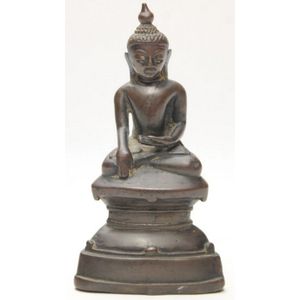19th Century Burmese Bronze Seated Buddha
You must be a subscriber, and be logged in to view price and dealer details.
Subscribe Now to view actual auction price for this item
When you subscribe, you have the option of setting the currency in which to display prices to $Au, $US, $NZ or Stg.
- Bronze - An alloy of copper and tin, traditionally in the proportions of about 9 parts of copper to 1 part of tin.
The discovery of bronze in Western Asia in the 4th century enabled people to create metal objects which were superior to those previoulsy possible because of its strength and hardness, and it has been used throughout the world for weapons, coins, tools, statuary and other decorative items.
It is very fluid in a molten state, and its hardness, strength when set, and non-corrosive properties makes it most suitable for casting sculpture. - Incised - A record of a name, date or inscription, or a decoration scratched into a surface, usually of a glass or ceramic item with a blunt instrument to make a coarse indentation. Compare with engraving where the surface is cut with a sharp instrument such as a metal needle or rotating tool to achieve a fine indentation.
- Finial - An architectural decoration, found on the upper parts of of an object. On furniture they are usually found on pediments, canopies and shelf supports. On smaller ceramic or silver items, such as spoons, they may decorate the top of the item itself, or the lid or cover where they provide a useful handle for removal.
Finials have a variety of shapes and forms. They may be urn-shaped, baluster shaped round or spiral, but usually taper into an upper point. Many real life shapes may also be used as finials, such as pineapples, berries, pinecones, buds, lotus and acorns. Sometimes animals such as a lion are depicted, or fish and dolphins.
This item has been included into following indexes:
Visually similar items

Thai' Buddha on cedar stand. Encased under glass dome. Provenance: Bungan Castle Museum collection. Height 17 cm (Buddha)

A bronze Shan style Buddha seated on a high throne with simple bands of beading, Burma 18th/19th century, a young serene face with high arched eyebrows above partly opened eyes, the tight curls with a domed shape ushnisha, a smooth copper-brown patina, hei

A rare bronze seated figure of Rishi, a stong smiling face, with a moustache & beard, Cambodia, 19th century, long braided hair in a high chignon held back by a tiara, embellished with jewellery, hands in a teaching gesture, the upper body entwined by King

A South-Central Indian bronze figure of Bhudevi/ Prithvi, probably late Vajayanagara period, circa 17th century, the Earth Mother incarnate is the mother of Sita. She holds the Utpala blue lotus in her right hand. the face heavily pujured, 16.2 cm high. Pr
